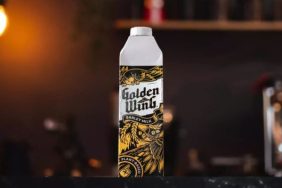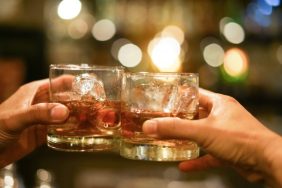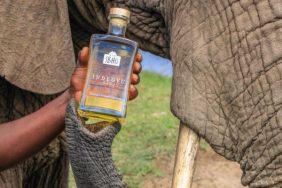It’s no surprise that “whisky” in Gaelic is “uisge beatha” or “water of life”. In essence, whisky and all other spirits are primarily composed of water. Without water, you don’t have alcohol.
Water is not only the largest component of any bottled spirit that is sold for human consumption (60% in a 40 abv alcohol is water) but, in the case of Martin Millers Gin, it also plays a vital role in the way the flavors are picked up from the botanicals and the mouth feel of the final product. “In fact, water from Iceland possesses certain characteristics that determine a high level of quality to any ‘drink’ product being produced in Iceland,” says David Bromige, Creative Director and co-founder of Martin Miller’s Gin, a brand that relies heavily on the use of pure, Icelandic water.
Water is by far the largest ingredient present in any gin, for that matter in any bottled spirit. “We have found that water, used correctly, can make the most of the botanicals we use in distillation and also create a great ‘mouthfeel’,” says Bromige.

The Icelandic water used by Martin Miller’s Gin has all characteristics a high-quality water needs. “The water is claimed by the Icelanders to be the purest in the world, having an average of only 8 to 30 parts per million of dissolved solids.” The purest non-Icelandic bottled waters, for example, contain upwards of 400ppm. “Coming originally from snow that fell over eight-hundred years ago and has formed as ice in a dormant volcanic caldera.”
The deepest, and oldest, ice is melted by heat from the volcano, and is stripped of its mineral content by a journey of filtration over a period of some eight-hundred years through the volcanic rocks until it is finally bought to rest in deep underground aquifers from where they draw the water to bottle Martin Millers Gin. “The water used emerges from the air tight confines of the aquifer as close to pure, naturally occurring H2o as it is possible to get.” This completely removes the necessity to artificially de-mineralize, or distill the water. “This natural demineralization gives Icelandic water a great advantage over the processed water of other spirits.”
This is because the process of de-mineralization, standard practice in virtually all drinks products utilizing water as an ingredient, while offering a bland, blank canvas of neutral taste, also has in the case of Icelandic water the unwelcome side effect of reducing the waters surface tension. “Early experiments blending Martin Miller’s Gin showed dramatic differences between blends using de-mineralized waters and Icelandic water drawn straight from the source.”
The trials using de-mineralized water lacked the soft mouth feel of Martin Miller’s Gin and delivered a less complex nose with a more ‘one-dimensional’ aspect where juniper was too dominant. “In addition, the ‘burn’ from the alcohol too was more intense.
Consultations with a number of expert opinions drew the conclusion that during the process of de-mineralization the relatively strong surface tension of Icelandic water was noticeably reduced,” says Bromige. From that it was deduced that this surface tension (essentially the barrier between air and water, formed on the surface of water by electrically charged molecules) was acting as an inhibitor to the evaporation of the distilled spirit from the water.
This had several beneficial effects. “First of all, it controlled the aromatics, giving Martin Miller’s Gin its signature complex nose where a balance between Juniper and citrus was most evident. Secondly, the reduced rate of evaporation of the spirit created a cooler, gentler, less ‘burning’ effect from the alcohol where heat was not experienced in the throat, but more as ‘pleasant warming sensation’. Thirdly, it gave the total package a more rounded softer ‘mouthfeel’.”
What Makes Great Water?
In the process of distillation, all but a fraction of the water used is lost as steam. “So, in the process of gin distillation its impact is minimal to say the least,” says Bromige. “Our view is that the water used for the distillation part of the process should be as bland a neutral as possible, this ensures that any impurity in the water does not impair the delicate process of distillation.”
On the other hand, the water used for blending in the alcohol content is brought down to a level at which it can be consumed is a very important factor. “The most usual, basic criteria for any water to be used in spirit production is that it is consistent and bland. This means it must be free of any minerals or impurities, as minerals will alter the flavor profile over time and create an inconsistent product.”
It is for this reason that virtually every single spirit brand produced uses de-mineralized water. “Some may claim to use spring water etc, but again on investigation you will find it has been passed through the de-mineralization/distillation/Pasteurizer processor.”
Due to the nature of Martin Miller’s Gin the pure water from our Icelandic source, which they use without industrial processing, is simply the best water they could find for blending, despite the expense. “Icelanders have a term for the untouched water we use, they call it ‘live water’ as opposed to de-mineralized or distilled water which they term ‘dead’. “
Although gin isn’t aged, Bromige understands how important the role of wood plays in an aged spirit. He believes that water, although important, is only trumped by aging in the right wood when you’re dealing with whisky, rum or other aged spirits. “Most distillers and blenders would agree that the spirit is the defining agent in the process of ageing.”
Most spirits are aged in barrels at what is called ‘cask strength’ i.e at a strength with little or no added water, so well above bottling strength. “The effects of wood vary hugely from different oak species through to whether the are Virgin casks or are utilizing and taking flavors from what was previously in the barrel, for example Sherry.”
The other factor is how long the spirit is aged in the barrel. “So, for example If you left a relatively light spirit, say a very light un-peated whisky, gin, or for that matter vodka for an extended period in the cask, then the dominating characteristic would become the cask containing it.”








